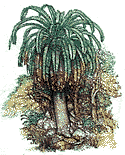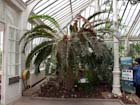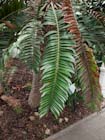
Mature plant. In 1999, copies of this painting could be obtained from the artist, Douglas Goode. As of 2004, the painting has disappeared from the Web.

Plant growing at Kew Gardens, UK. This is one of the earliest scions of the wild plant, and is very large and healthy [C.J. Earle, 2010.06.14].

One frond on the Kew plant [C.J. Earle, 2010.06.14].

Encephalartos woodii
Sander 1908
Common names
Taxonomic notes
Only a single plant, a male, has ever been found in the wild; see Remarks.
Efforts are underway to produce females by hybridization with E. natalensis and repeated backcrossings (Jones 1993).
Description
"[S]tem up to nearly 20 feet (6 m) tall, with a dense, umbrella-shaped crown of leaves. These are long, up to just over 8 feet (roughly 2.5 m), arching and spreading, woolly-brown at first and dark green and smooth later. The leaflets are reduced to prickles at the base. The middle ones are broad, up to 2 inches (5 cm) in width, and up to about 8 inches (20 cm) in length, the lower margins sometimes toothed. ... The male cones are 1 to several, large and orange-yellow" (Palmer & Pitman 1972).
Distribution and Ecology
Remarkable Specimens
I have no data for the wild plants. Three specimens in Durban Botanical Garden, South Africa were measured by Robert Van Pelt (pers. comm., 2003.11.24) as:
- 73 cm dbh, 7.3 m tall.
- 76 cm dbh, 7.0 m tall.
- 91 cm dbh, 6.7 m tall.
As noted below, two of these were from the original wild plant.
Ethnobotany
Observations
Remarks
"This cycad ... was first recorded by Medley Wood, the Natal botanist, in Ngoye Forest in Zululand in 1895. This was a solitary, tall, 4-stemmed plant with a few off-shoots at the base. Some of the off-shoots were later collected by John Wylie and cultivated in this country and abroad. In 1907 Wylie collected two of the large trunks which were planted - and still grow - in the Durban Botanic Garden, and about 1916 what is believed the last stem was removed from Ngoye. This is probably the plant in the National Botanic Garden of the Botanical Research Institute in Pretoria.
"The original plant was a male. All cultivated plants are suckers from it and a female plant is not known. Expedition after expedition has been made to Ngoye to discover another specimen but up-to-date all have proved fruitless.
"The specific name honours Medley Wood, Natal's grand old veteran botanist. The Kew Bulletin of 1914 reproduced an historic photograph of him standing next to a tree in the Durban Botanic Gardens, the arching leaves making a background for his great white beard" (Palmer & Pitman 1972).
See also


